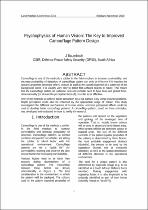JavaScript is disabled for your browser. Some features of this site may not work without it.
- ResearchSpace
- →
- Research Publications/Outputs
- →
- Conference Publications
- →
- View Item
| dc.contributor.author |
Baumbach, J

|
|
| dc.date.accessioned | 2011-01-14T10:55:30Z | |
| dc.date.available | 2011-01-14T10:55:30Z | |
| dc.date.issued | 2010-11 | |
| dc.identifier.citation | Baumbach, J. Psychophysics of human vision: The key to improved camouflage pattern design. Land Warfare Conference 2010 - Full Spectrum Threats: Adaptive Responses, Brisbane, Australia from 15 - 19 November 2010, pp 6 | en |
| dc.identifier.isbn | 9780980872309 | |
| dc.identifier.uri | http://hdl.handle.net/10204/4764 | |
| dc.description | Land Warfare Conference 2010 - Full Spectrum Threats: Adaptive Responses, Brisbane, Australia from 15 - 19 November 2010 | en |
| dc.description.abstract | Camouflage is one of the methods a soldier in the field employs to increase survivability, and decrease probability of detection. A camouflage pattern can only be effective if it matches the spectral properties (amongst others, colour) as well as the spatial properties (i.e. patterns) of the background scene. It is usually very easy to detect flat-surfaced objects in nature. This means that the camouflage pattern on uniforms, nets and vehicles need to have local and global three dimensionality (or at least the perception there-of), in order to be effective. One of the methods to achieve depth perception on a flat surface is by using textured gradients. Depth perception could also be enhanced by the appropriate usage of colour. This study investigated the different mechanisms of human vision, and how perceptual effects could be used to develop better camouflage patterns. A camouflage pattern, based on these principles, was developed and evaluated in order to verify the research. | en |
| dc.language.iso | en | en |
| dc.relation.ispartofseries | Conference Paper | en |
| dc.subject | Camouflage patterns | en |
| dc.subject | Psychophysics | en |
| dc.subject | Human vision | en |
| dc.subject | Land warfare | en |
| dc.subject | Camouflage | en |
| dc.title | Psychophysics of human vision: The key to improved camouflage pattern design | en |
| dc.type | Conference Presentation | en |
| dc.identifier.apacitation | Baumbach, J. (2010). Psychophysics of human vision: The key to improved camouflage pattern design. http://hdl.handle.net/10204/4764 | en_ZA |
| dc.identifier.chicagocitation | Baumbach, J. "Psychophysics of human vision: The key to improved camouflage pattern design." (2010): http://hdl.handle.net/10204/4764 | en_ZA |
| dc.identifier.vancouvercitation | Baumbach J, Psychophysics of human vision: The key to improved camouflage pattern design; 2010. http://hdl.handle.net/10204/4764 . | en_ZA |
| dc.identifier.ris | TY - Conference Presentation AU - Baumbach, J AB - Camouflage is one of the methods a soldier in the field employs to increase survivability, and decrease probability of detection. A camouflage pattern can only be effective if it matches the spectral properties (amongst others, colour) as well as the spatial properties (i.e. patterns) of the background scene. It is usually very easy to detect flat-surfaced objects in nature. This means that the camouflage pattern on uniforms, nets and vehicles need to have local and global three dimensionality (or at least the perception there-of), in order to be effective. One of the methods to achieve depth perception on a flat surface is by using textured gradients. Depth perception could also be enhanced by the appropriate usage of colour. This study investigated the different mechanisms of human vision, and how perceptual effects could be used to develop better camouflage patterns. A camouflage pattern, based on these principles, was developed and evaluated in order to verify the research. DA - 2010-11 DB - ResearchSpace DP - CSIR KW - Camouflage patterns KW - Psychophysics KW - Human vision KW - Land warfare KW - Camouflage LK - https://researchspace.csir.co.za PY - 2010 SM - 9780980872309 T1 - Psychophysics of human vision: The key to improved camouflage pattern design TI - Psychophysics of human vision: The key to improved camouflage pattern design UR - http://hdl.handle.net/10204/4764 ER - | en_ZA |






